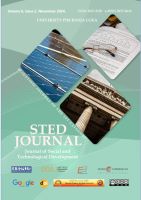SEQUESTRATION OF CIPROFLOXACIN FROM AQUEOUS SOLUTIONS BY NANOCOMPOSITE OBTAINED VIA MORINGA OLEIFERA PODS AND FELDSPAR CLAY MODIFICATION
SEQUESTRATION OF CIPROFLOXACIN FROM AQUEOUS SOLUTIONS BY NANOCOMPOSITE OBTAINED VIA MORINGA OLEIFERA PODS AND FELDSPAR CLAY MODIFICATION
Author(s): Mokete John Phele, Fanyana MtunziSubject(s): Geography, Regional studies
Published by: Univerzitet za poslovni inženjering i menadžment
Keywords: Moringa Oleifera; Carbonaceous materials; feldspar clay; Ciprofloxacin; Sorption;
Summary/Abstract: The environmental hazards of antibiotics have captivated increasing research focus, but their environmental behaviours remain unclear in water sources. Thus, this study focused on exploring the interaction mechanisms between Moringa Oleifera pod-modified feldspar clay (MFC) and ciprofloxacin (CIP) during sorption process. The efficiency of these adsorbents in aqueous solution adsorption of CIP were investigated as a function of pH, time and sorbate concentration. The impact of pH solution and CIP evolution showed that CIP sorption on MFC is strongly reliant on pH solution. Kinetic studies authenticated that the CIP sorption mechanism was a physisorption involving ion exchange and surface complexation mechanisms. The mechanism of CIP sorption on MFC was successfully studied using characterization techniques. The Langmuir and Freundlich isotherm equations were used to analyze the equilibrium isotherm data. The adsorption process fitted well with the second-order kinetics and the Langmuir isotherm equation fitted well with the experimental data. The Langmuir isotherm showed that maximum adsorption capacity was found to be 57.61 mg/g. Thermodynamic factors: ΔG° values of -29 kJ/mol, ΔH° = 17 kJ/mol, and ΔS° = 163 J/mol.k of CIP adsorbed onto MFC indicate that the adsorption was spontaneous and endothermic in nature.
Journal: Časopis o društvenom i tehnološkom razvoju
- Issue Year: 6/2024
- Issue No: 2
- Page Range: 25-38
- Page Count: 14
- Language: English

